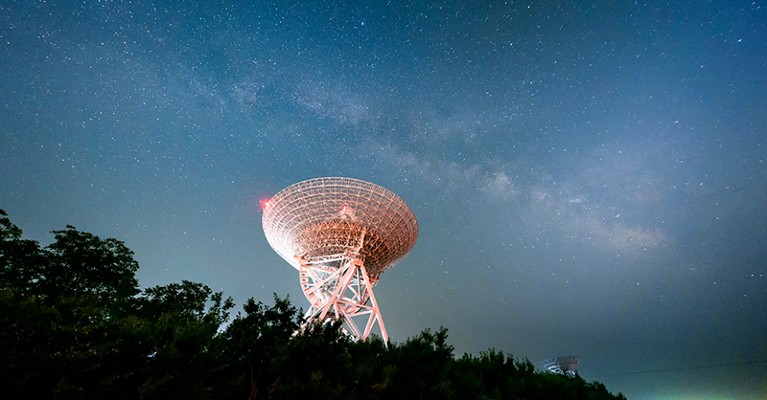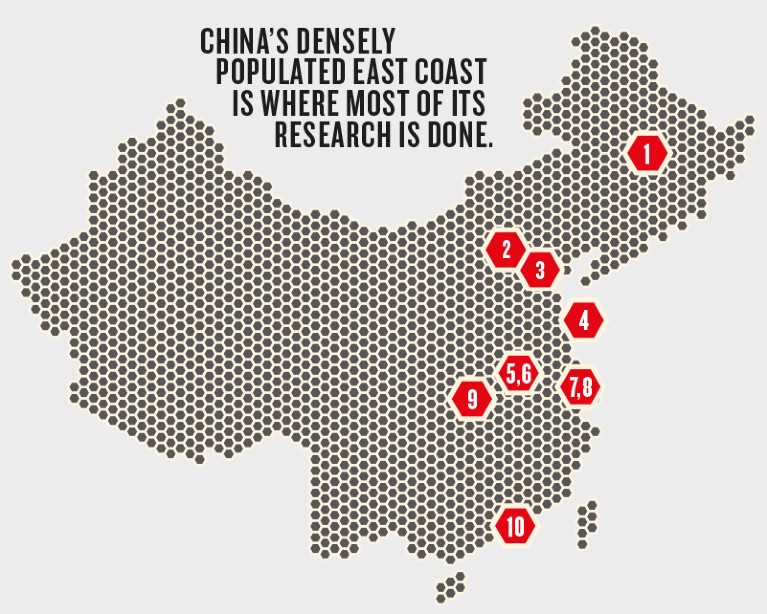
A radio telescope in Miyun district, Beijing.Credit: Haitong Yu/Getty
When it comes to China’s biggest achievements in science in recent years, many are quick to point to the world’s first quantum-communication satellite. Launched in 2016, the spacecraft has already enabled researchers to prove quantum principles that could enable an unhackable communications network.
It’s one of many visionary and large-scale research projects that China has launched with the aim of becoming a science and technology global leader by 2049, the centenary of the founding of the People’s Republic of China.
According to research published in June last year, the satellite sent two entangled photons from space to ground stations more than 1,200 kilometres apart, as part of China’s two-year Quantum Experiments at Space Scale (QUESS) mission, also called Micius after the ancient Chinese philosopher. The results demonstrated that the photons remained linked, providing proof that quantum entanglement can endure great distances. Entangled photons could theoretically serve as the basis for a completely secure communications network that hackers cannot penetrate without detection.
Scientists across the country were involved, from physicists working on the fundamentals at the University of Science and Technology of China in the growing science hub of Hefei to those receiving the photons at observatories in the northwest city of Qinghai and southerly city of Lijiang. The project was impressive not just because it could revolutionize the way humans interact, but because it was an entirely Chinese effort. “This research ranges from fundamental science to practical application, and it is a real successful model made in China,” said Zhiyong Tang, professor of materials science at the National Center for Nanoscience and Technology in Beijing.
World leading
When Micius’s results were announced, international physicists recognized that China is becoming a world leader in quantum-satellite technology. A second satellite is already planned, as well as the largest ever quantum research facility, which will, among other research, work on stealth technology for submarines that will make them harder to detect.
Other space-science projects have also made headlines. The unmanned lunar spacecraft Chang’e-3 launched in 2013, and made China only the third country to land on the Moon. And 2016 saw the launch of the nation’s most powerful rocket to date, the Long March-7, which will eventually supply China’s planned space station. The country also launched its first X-ray telescope last year.

In the remote southwestern province of Guizhou, China has finished constructing the world’s largest single-dish radio telescope. The half-a-kilometre-wide dish, known as the Five-hundred-meter Aperture Spherical radio Telescope (FAST), was lauded as a unique feat of civil engineering. It is being used to detect radio messages from across the Universe to research phenomena such as dark matter and black holes, as well as listen out for indications of extraterrestrial life.
But China’s scientists aren’t just interested in what’s above. Jiaolong, the country’s first manned deep-sea submersible, reached a depth of 7,020 metres in 2012, a record for a scientific research vessel. In 2020, it will go on a one-year scientific research mission along the Pacific, Atlantic and Indian Ocean beds.
Grand science designs
There is every reason to think that China will continue to fund such grand projects for many years to come. Last October, President Xi Jinping told officials at the Communist Party’s twice-a-decade national congress that the country must aim to reach new frontiers in science and technology. “We will strengthen basic research in applied sciences, launch major national science and technology projects, and prioritize innovation in key generic technologies, cutting-edge frontier technologies, modern engineering technologies, and disruptive technologies,” he was reported as saying by Chinese state media.
In May 2017, the Shenzhen Grubbs Institute was launched at the Southern University of Science and Technology in Shenzhen. Backed by the Guangdong provincial government, the institute has launched a recruitment blitz to draw the “world’s brightest minds”. The institute, named after the 2005 Nobel Prize in Chemistry winner Robert H. Grubbs, will focus on the research and commercialization of drugs, materials and clean energy, beginning with plastics and polymers.
Grubbs praised the local infrastructure for rapidly commercializing discoveries in an interview with the state-owned broadcaster China Global Television Network. Reputation was key to attracting talent, he added. “You build a reputation of this department and this campus as really a great place to do science and research. Once you develop that reputation, everyone wants to come. So then you get the best.”



 Why an Italian astrophysicist decided to move to Shanghai
Why an Italian astrophysicist decided to move to Shanghai
 How private-sector research is changing China
How private-sector research is changing China








